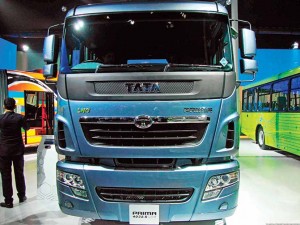Tata Motors is bullish about LNG powered commercial vehicles.
Story by:
Bhushan Mhapralkar
Tata Motors showcased a LNG (Liquefied Natural Gas) powered bus at Thiruvananthapuram, Kerala, recently. It did so in association with Petronet LNG Limited (PLL) and the Indian Oil Corporation Ltd. The bus is based on the Tata LPO1613 platform, which is currently available with a CNG engine. With plans being drawn to launch the LNG bus by April next year, it is clear that Tata Motors sees a good future for such buses. Expressed Dr. A K Jindal, Head – Engineering Research Centre, Commercial Vehicles, Tata Motors, that Kerala is keen to place an order for 10,000 buses, with 10 per cent of them, LNG powered. The supply constraints posed by CNG infrastructure makes LNG a logical extension for CV manufacturers like Tata Motors, and the operators, it s clear. There are other issues too. “To increase the range of a CNG powered bus (from 300 km), more storage cylinders will be needed. This will adversely affect the power to weight ratio, payload capacity and seating capacity,” he says. In the case of trucks, the additional weight of the CNG tanks lowers the payload capacity. With gas prices on the rise, a CNG truck or bus operator will have to visit the CNG bunk more often. This will limit the travel range. Avers Dr. Jindal, “Limited availability of CNG will lead to time wastage.”
LNG for longer range
The possibility of powering a city bus, or an inter-city bus that travels longer distances on a single fill is perhaps the biggest advantage LNG may offer. LNG terminals, as of current, are under utilised. According to Dr. Jindal, “Operators find it risky to operate CNG vehicles, what with the lack of CNG infrastructure. “We therefore expect a migration to LNG.” India has a long contract with Qatar for gas. It is transported to the western coast of the country in the form of Liquified Natural Gas (LNG). The government has invested in infrastructure at the ports of Dahej, Kochi, Dabhol, and Hazira along the western coast of India. These terminals are under utilised,” he adds. If the under utilised terminals provide an opportunity to set up LNG dispensing pumps, the need is to understand customer needs from a transportation point of view. One big advantage is the cost of LNG. It is expected to be 30 to 40 per cent cheaper than that of a diesel. States Dr. Jindal, “LNG powered vehicles (trucks and buses) make good candidates. They were not fitted with CNG because they would find it difficult to fill; LNG has a two-and-a-half times more per litre capacity than diesel. The range therefore will be between 600 to 700 km.”
Advantage Kochi
The LNG terminal at Kochi has got the Kerala Government interested, claim industry sources. They add that it is therefore that Tata Motors chose to showcase their LNG bus at Thiruvananthapuram. With an LNG dispensing unit being setup at Kochi, it can be expected that over time, the whole of Kerala will be covered as it amounts to a radii of 300 to 400 km from Kochi. Mentions Dr. Jindal, “The indications we are getting are that LNG can be easily transported from the port to a distance of 500 km. Any further, and the chances of 30 to 40 per cent cost advantage being neutralised are more.” With the erection of five to six LNG dispensing stations being planned along the Mumbai-Delhi corridor, a distance of 1200 km, LNG as an automotive fuel is expected to get a shot in the arm. For proliferation of LNG, a terminal is said to be under construction at Haldia. It would support LNG-powered barges running upstream of the river Ganga. “Big plans for LNG are being chalked out,” states Dr. Jindal. He mentions, “Commercial vehicles will benefit from such an exercise.”
For its part, Tata Motors has been working on LNG for sometime now. With gas companies forthcoming, according to Dr. Jindal, the push for LNG is rising. “We displayed a LNG powered Prima four years ago. We also took efforts to get the government to declare LNG fuel as an automotive fuel,” he adds. Rules were framed in the last three-four years to ensure the use of LNG as an automotive fuel. With regulatory framework in place, the potential for LNG commercial vehicles is looking up.
Cleaner and better
Coming out of natural gas fields, it is about compressing the gas to make it easy to transport it in cylinders. The density of CNG is 16 kg per litre of volume; LNG density is 41 to 42 kg per 100 litre, which makes it 2.5 times denser than CNG. A gas derived product, LNG is clean. It is claimed to reduce greenhouse gas emissions by 30 per cent with respect to conventional liquid fuels. According to Dr. Jindal, the possibility of impurities finding their way into CNG fuel is more. “Since LNG is liquefied, impurities are unable to find a way into it. LNG is thus pure methane,” he quips. Cleaner than CNG, LNG also rises up in the instance of leakage. It is safe because it operates at lower pressure and evaporates quickly. It is lighter than air and evaporates extremely quickly under atmospheric pressure and temperature. Opines Dr. Jindal, that LNG is safe, and without any known incidents in vehicles.
In trucks, he claims, LNG has a clear potential to enhance the TCO. Compared to CNG buses and trucks, the performance of LNG trucks and buses may not be very different, he adds. “The advantage however will be less weight due to weight saving in areas like cylinders,” he says. If the need for more performance is felt, a solution, explains Dr. Jindal, would be to offer higher horsepower engines. “With a turbocharged engine, we have been able to get the same amount of power from a CNG engine as a diesel engine,” he adds. The DMRC buses Tata Motors has supplied to Delhi make a good example in terms of drive-ability. A turbocharged four-cylinder engine can develop the same power as that of a diesel engine. Pure methane in the form of LNG is expected to ensure superior performance over CNG. With pure methane content, engine knocking is taken care of, and efficiency increases. Thermal efficiency, according to Dr. Jindal, will be better in the case of LNG. Like all CNG engines, that are BSIV emission norms compliant, LNG engines will also be BSIV emission compliant. From 2020, they will be BSVI compliant. The liquified form that LNG is in, makes it 95 per cent Methane in content. This makes LNG one of the most purest gases available.
LNG conversion
To attract truck operators to LNG is going to be a big challenge, and Dr. Jindal is aware of it. He opines, “LNG will make a superior proposition for trucks operating in regions like Delhi NCR. A trucker going from Trivandrum to Guwahati will however not be enticed by the propsect of LNG; not unless and until he gets supporting LNG infrastructure to bank upon.” The introduction of LNG trucks is most likely to be limited to dedicated corridors therefore. Buses will be the first to get LNG. The 30 to 40 per cent cost saving will be a big enabler. Making practical sense for heavy vehicles because the return on investment in the case of heavy duty LNG vehicles will be faster, one may also consider the fact that cryogenic cylinders, as of now, are of the size suitable for bigger CVs. Fitted to small CVs, they would make a costlier proposition as far as the total cost is concerned. Efforts to package LNG on smaller CVs, except the very small ones like the Ace, are on.
Pricing
Pricing is one area that Tata Motors is working on as far as LNG commercial vehicles are concerned. Cryogenic tanks, according to Dr. Jindal, are imported. Their prices are high. Work is on to ensure that the prices are brought down to a reasonable and competitive level. Local development of tanks is underway. While that happens, the biggest pull for LNG will come from a (total cost of operation) saving of between 30 to 40 per cent. Dr. Jindal is of the opinion that LNG buses will pick up faster. Trucks will take longer because of their pattern of usage. It would entail an amount of confidence building as far as truckers are concerned. “By mid-next year we will be ready with buses. We will be ready for trucks by the end of next year. It will take time even though we do not see packaging as a challenge in this case,” signs off Dr. Jindal.
Tata LPO1613
In the CNG form, the Tata LPO1613 platform measures 11120 mm in length. Available as a cowl chassis with a 900 mm floor height, the platform, designed to spring a bus, is powered by a naturally aspirated 5.7-litre BSIV water cooled engine that does 96 Kw at 2500 rpm, and 405 Nm of peak torue between 1250 and 1500 rpm. The transmission is GBS-40 synchromesh unit with six gears. The bus chassis is fitted with five CNG cylinders of 650-litre. The cryogenic cylinders on the LNG LPO1613 bus showcased in Kerala are imported, and known to provide a range of between 600 and 700 km. The LPO1613 chassis is built at the company’s Lucknow plant. The body is built by Marcopolo at their Dharwad plant.






















